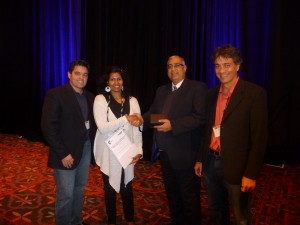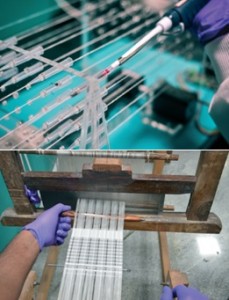Optofluidic holographic microscopy with custom Field of View by a linear array detector
Active pneumatic control of centrifugal microfluidic flows for lab-on-a-chip applications
Moving droplets between closed and open microfluidic systems
Lab on a Chip will again join forces with Corning Incorporated to award the ninth ‘Pioneers of Miniaturisation’ Lectureship at µTAS, including a certificate of recognition and a prize of $5000.
Miniaturisation plays a significant role in our daily lives; devices are becoming smaller and smaller, and this trend is set to continue. Current micro and nano fluidic research encompasses many scientific developments and technologies that will increase our understanding of phenomena at the micro and nano scale and potentially have a huge positive impact on our lives in the future. The use of micro and nano fluidic technologies will impact on a diverse range of industries ranging from their use in motor cars, through health improvement applications and to their use in protecting national and environmental security needs.
Nomination Deadline: 10th July 2015
At Lab on a Chip, we strongly believe in this technology and have been willing to show the necessary commitment and financial support to back the development of this research community. It is in this vein we present this award to honour and support the up and coming, next generation pioneers in this field of endeavour. This years lectureship will be presented at the µTAS 2015 Conference in Gyeongju, Korea.
Who should you nominate?
Who has won the Pioneers of Miniaturisation Lectureship in the past?
How do I nominate?
These HOT articles published in March 2015 were recommended by our referees and are free* to access for 4 weeks
J. R. Buser, A. Wollen, E. K. Heiniger, S. A. Byrnes, P. C. Kauffman, P. D. Ladd and P. Yager
Lab Chip, 2015,15, 1994-1997
DOI: 10.1039/C5LC00080G, Technical Innovation
Implementation of in situ SAXS/WAXS characterization into silicon/glass microreactors
Thomas Beuvier, Elvia Anabela Chavez Panduro, Paweł Kwaśniewski, Samuel Marre, Carole Lecoutre, Yves Garrabos, Cyril Aymonier, Brice Calvignac and Alain Gibaud
Lab Chip, 2015,15, 2002-2008
DOI: 10.1039/C5LC00115C, Paper
Abhiteja Konda, Jay M. Taylor, Michael A. Stoller and Stephen A. Morin
Lab Chip, 2015, 15, 2009-2017
DOI: 10.1039/C5LC00026B, Paper
Take a look at our Lab on a Chip 2015 HOT Articles Collection!
Fabrication and Characterization of Optogenetic, Multi-Strip Cardiac Muscles
Direct detection and drug-resistance profiling of bacteremias using inertial microfluidics
Droplet-in-oil array for picoliter-scale analysis based on sequential-inkjet printing
The microenvironment of double emulsions in rectangular microchannels
 The μTAS conference 2014 was held in October, at the Henry B. Gonzalez Convention Center in San Antonio, Texas.
The μTAS conference 2014 was held in October, at the Henry B. Gonzalez Convention Center in San Antonio, Texas.
As in previous years, Harp Minhas, Editor of Lab on a Chip, was in attendance at the conference to announce the prestigious Lab on a Chip awards, which include the Pioneers of Miniaturisation Lectureship (supported by Corning Inc), the Widmer Young Researcher Poster Prize, and the Art in Science Award (co-sponsored by NIST).
New to 2014: The μTAS Video Competition, created in partnership with Dolomite Microfluidics and supported by the CBMS (the Chemical and Biological Microsystems Society) was awarded for the first time at this years conference!
Art in Science Award
The Art in Science Award is given each year “to draw attention to the aesthetic value in scientific illustrations while still conveying scientific merit.” This year’s award was presented to David Castro and research group form the King Abdullah University of Science and Technology (KAUST) in Saudi Arabia. More information on the winning photograph can be found on our competition blog.

Left to Right: Darwin Reyes (NIST) Shilpa Sivashankar (KAUST) Harpal Minhas (LOC) and Albert Folch (University of Washington)
Pioneers of Miniaturisation Lectureship
The Pioneers of Miniaturisation Lectureship recognises early-mid career scientists who demonstrate outstanding achievements and significant contributions to the understanding and advancement of micro- and nano-scale science. This year, the Lectureship was awarded to Sangeeta Bhatia, Massachusetts Institutes of Technology. Dr Bhatia received a certificate, $5000 and gave a short lecture at the conference. You can find out more about Dr Bhatia on our winners blog.
Video Competitions
New to 2014 and created in partnership with Dolomite Microfluidics and supported by the CBMS (the Chemical and Biological Microsystems Society) the video competiton was awarded to Tijmen Hageman and colleagues. Prior to the conference, μTAS participants were invited to submit short, scientifically or educationally focused videos. The winning group, a collaboration of researchers from the University of Twente and the Korean Institute of Science and Technology produced a video demonstrating that bacteria can be manipulated by a magnetic field by using magnets to teach bacteria to line dance. The full video can be viewed on our competition blog.
Please join us at Lab on a Chip in congratulating all of our prize winners! We look forward to seeing you at μTAS 2015 in Gyeongju, Korea.
Lab on a Chip presents uTAS Abstracts 2003 to 2014:
 The page link below gives the lab on a chip/microfluidics/μTAS communities free access to both current and archived content submitted to the μTAS conferences in the form of extended abstracts. This service will support workers in finding essential references and hence increase knowledge of past work in the field and assist with current and future research.
The page link below gives the lab on a chip/microfluidics/μTAS communities free access to both current and archived content submitted to the μTAS conferences in the form of extended abstracts. This service will support workers in finding essential references and hence increase knowledge of past work in the field and assist with current and future research.
Abstracts are available through the following link: http://rsc.li/1eYWXQs
This archive includes abstracts presented at uTAS meetings from 2003 to present and essentially provides easy web access to the abstract discs supplied at the uTAS meetings.
Webwriter Claire Weston @imperialcollege writes more…
Electrochemical sensors are widely used as analytical tools. They are disposable, cheap to make, and small – making them ideal for many applications.
The current method for commercial electrochemical sensors uses screen printing onto plastic or ceramic surfaces to generate the circuit elements, which requires specialised fabrication equipment. This screen printing method also leads to wastage of electrode inks and reagents. One way of avoiding these issues is using paper microfluidics – Professor George Whitesides is a well-known name in this field.
 Dendukuri and coworkers, from Achira Labs, Bangalore, have come at this problem from a different angle. They have developed an alternative approach using textile weaving. Instead of screen printing, they coat their yarn with the required reagents in a way that results in no wastage, as shown in the photo. They use silk as their material which is biodegradable, unlike the plastics usually used. It is also easily processed – initially silk is hydrophobic but it can be made hydrophobic by degumming. This can be achieved by simply boiling the yarn.
Dendukuri and coworkers, from Achira Labs, Bangalore, have come at this problem from a different angle. They have developed an alternative approach using textile weaving. Instead of screen printing, they coat their yarn with the required reagents in a way that results in no wastage, as shown in the photo. They use silk as their material which is biodegradable, unlike the plastics usually used. It is also easily processed – initially silk is hydrophobic but it can be made hydrophobic by degumming. This can be achieved by simply boiling the yarn.
To make the sensors, electrode yarns are prepared by coating in conductive inks and reagents, and then woven into the fabric. Large numbers of sensors can be woven as patches on the fabric, which are then stuck onto an adhesive backing and laminated, leaving a window for application of the sample and for contact with a reader.To demonstrate this effectiveness of this new method, the authors developed glucose and haemoglobin sensors. The glucose sensors were found to have a clinically acceptable performance, according to FDA criteria, while the haemoglobin sensors were able to detect physiologically relevant concentrations. Multiplexed sensors capable of detecting more than one analyte were easily prepared by adding an additional electrode.
One of the most pleasing aspects of this new method, is its potential in the developing world, where weaving is still widely used. In addition, the cost of manufacture was calculated as less than 20 USD per 1000 sensors and this could even lower on scale up.
To download the full article for free* click the link below:
Woven electrochemical fabric-based test sensors (WEFTS): a new class of multiplexed electrochemical sensors
Tripurari Choudhary, G. P. Rajamanickam and Dhananjaya Dendukuri
DOI: 10.1039/C5LC00041F
*Access is free until 30.04.2015 through a registered RSC Personal Publishing Account
Alphonsus Ng @Wheeler_Lab writes more…
Since its inception over 50 years ago, inkjet printing has become the most widely adopted method for the reproduction of images and text on paper. Inherently a microfluidic technology, inkjet printing is a process in which individual ink droplets, between 10 to 100 µm diameters, are placed at software-configurable locations on a substrate. The resulting dots can combine to create photo-quality images with resolutions of up to several thousand dots per inch. Such exquisite precision and flexibility make inkjet printing particularly attractive for the scalable fabrication of fine features. Indeed, in addition to coloured inks, this technology has also been adapted to deposit a wide range of materials for manufacturing, including metals, ceramics, polymers, and even biological cells.1
Not surprisingly, the lab on a chip community is also beginning to leverage printing technologies for the fabrication of microfluidic components.2 However, this is not straightforward because the quality of the printed features often depends on the interaction of the ink droplets with the substrate material. Since microfluidic devices are predominantly prototyped using polydimethylsiloxane (PDMS),3 recent research has focused on the development of PDMS-compatible methods for inkjet printing.
In one example, Profs Dachao Li at the Tianjin University, China and Robert C. Roberts at the University of Hong Kong used inkjet printing to form robust silver microelectrodes on PDMS-based microfluidics for glucose sensing.4 In forming these electrodes, the PDMS material posed two challenges: 1) poor adhesion of silver to PDMS inhibited robust electrode formation and, 2) the inherent hydrophobicity of PDMS promoted coalescence of neighboring ink droplets, which impaired the precision of printed features.
To overcome these challenges, the researchers modified the substrate using (3-Mercaptopropyl)trimethoxysilane, a coupling reagent that presents thiol groups on the PDMS surface. The thiol groups not only served as covalent anchoring sites for the inkjet-printed silver but also increased the wettability of the ink droplet, which improved the precision of the printed features.
Remarkably, the printed electrodes formed on these substrates tolerated very harsh stress tests, including immersion in water, exposure to high pressure air stream, and even ultrasonication. This new fabrication strategy enabled the team to create an all-in-one PDMS system with fluid handling and a three-electrode electrochemical cell for transdermal detection of glucose (Picture 1).
In another example, Profs Yanlin Song and Fengyu Li at the Chinese Academy of Sciences, China developed an elegant inkjet-printed method 5 for the fabrication of enclosed PDMS microchannels. This process conventionally requires at least 4 steps: 1) create a solid template via photolithography, 2) cast PDMS prepolymer mixture in the template, 3) cure and separate the PDMS from the template, and 4) bond the molded PDMS to a substrate.
To simplify this procedure, the researchers implemented a liquid template formed by inkjet-printing (Picture 2). Here, an immiscible liquid pattern is printed directly on a pool of PDMS prepolymer solution. Within seconds, the liquid spontaneously submerges below the prepolymer solution and acts as a template. Upon heating, the polymer solidifies while the liquid template evaporates, leaving behind an enclosed PDMS microchannel device.
In the development of this method, one major challenge was maintaining the stability of the liquid template in the prepolymer solution. Due to surface tension, printed liquid templates tend to break up and relax into discontinuous spherical droplets. Although this instability can be inhibited by increasing the liquid viscosity, high viscosities are not compatible with inkjet printing. To address this challenge, the researchers used an ink whose viscosity is tunable by temperature. At room temperature, the ink has relatively low viscosity (10 centipoise), which is compatible with inkjet printing. When the ink is printed on a cooled (3-4oC) pool of prepolymer solution, the viscosity of the liquid increases dramatically (>40 centipoise), which enabled the formation of a stable liquid template with no breakages.
This inkjet-printed approach enabled the formation of remarkably versatile PDMS microchannels. The diameters of the fabricated channels can range from 100 to 900 µm just by changing the template design. In addition, the interior surface of the channel can be modified by including vinyl-terminated functional molecules in the ink composition, which covalently incorporates in the PDMS matrix during thermal curing. Applying this technique with vinyl-terminated poly(ethylene glycol)methacrylate molecules, the researchers effortlessly imbue their devices with protein fouling resistance.
In summary, the lab on a chip community is beginning to leverage the benefits of inkjet printing in the fabrication of microfluidic components. By engineering the interaction of the ink droplets with the substrate material, researchers are devising innovative ways to fabricate robust electrodes and versatile microchannels without the need for cleanroom facilities and complicated procedures.
1. I. M. Hutchings and G. D. Martin, Inkjet technology for digital fabrication, John Wiley & Sons, 2012.
2. P. Tseng, C. Murray, D. Kim and D. Di Carlo, Lab on a Chip, 2014, 14, 1491-1495.
3. E. Berthier, E. W. K. Young and D. Beebe, Lab on a Chip, 2012, 12, 1224-1237.
4. J. Wu, R. Wang, H. Yu, G. Li, K. Xu, N. C. Tien, R. C. Roberts and D. Li, Lab on a Chip, 2015, 15, 690-695.
5. Y. Guo, L. Li, F. Li, H. Zhou and Y. Song, Lab on a Chip, 2015, 15, 1759-1764.
These HOT articles published in February 2015 were recommended by our referees and are free* to access for 4 weeks
On-chip surface acoustic wave lysis and ion-exchange nanomembrane detection of exosomal RNA for pancreatic cancer study and diagnosis
Daniel Taller, Katherine Richards, Zdenek Slouka, Satyajyoti Senapati, Reginald Hill, David B. Go and Hsueh-Chia Chang
Lab Chip, 2015,15, 1656-1666
DOI: 10.1039/C5LC00036J, Paper
Three-dimensional heterogeneous assembly of coded microgels using an untethered mobile microgripper
Su Eun Chung, Xiaoguang Dong and Metin Sitti
Lab Chip, 2015,15, 1667-1676
DOI: 10.1039/C5LC00009B, Paper
A flexible lab-on-a-chip for the synthesis and magnetic separation of magnetite decorated with gold nanoparticles
Flávio C. Cabrera, Antonio F. A. A. Melo, João C. P. de Souza, Aldo E. Job and Frank N. Crespilho
Lab Chip, 2015, Advance Article
DOI: 10.1039/C4LC01483A, Paper
Take a look at our Lab on a Chip 2015 HOT Articles Collection!